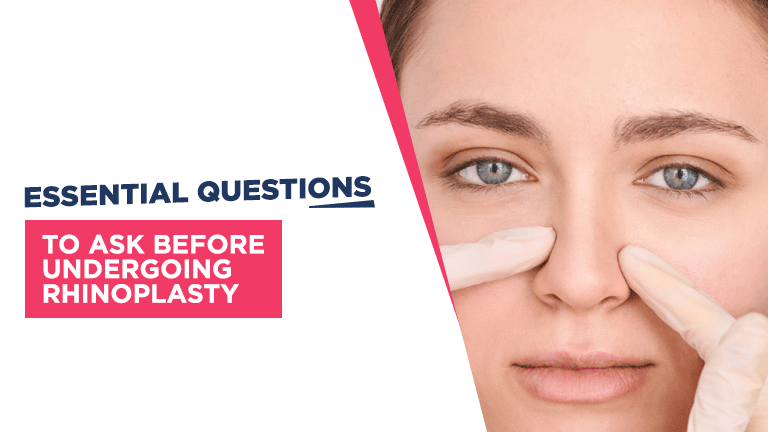
How long before the wedding should a bride get a HydraFacial?
All brides desire to have glowing, redless skin on the

Rhinoplasty is a transformative surgical procedure aimed at reshaping the nose to improve its appearance and function. People seek nose job, commonly referred to as a nose job, for a variety of reasons, including congenital deformity correction, Rhinoplasty treatment in delhi , and facial harmony enhancement, regardless of whether they are driven by medical or aesthetic goals.
One of the foremost concerns potential patients have is the permanence of rhinoplasty results. Understanding the longevity of these results is crucial for setting realistic expectations and making informed decisions about undergoing the procedure. This article explores whether rhinoplasty results are permanent, exploring the factors that influence the outcome and how long-lasting changes can be achieved.
Rhinoplasty is a surgical procedure designed to alter the shape, size, and structure of the nose shaping . This operation can address both aesthetic and functional concerns, helping individuals achieve a nose that complements their facial features or improves their breathing. Rhinoplasty can involve modifications to the bone, cartilage, skin, or all three, depending on the desired outcome.
Understanding the factors influencing them helps patients make informed decisions and prepare for their transformative journey toward a more functional and aesthetically pleasing nose.
The success of a rhinoplasty procedure heavily depends on the surgical technique and the expertise of the surgeon. Choosing a skilled and experienced surgeon is crucial because they bring a deep understanding of nasal anatomy and aesthetics, ensuring the procedure is tailored to the patient’s unique facial features and goals.
An experienced surgeon can effectively plan the surgery, execute it with precision, and manage postoperative care to optimize the outcomes. Different techniques, such as open rhinoplasty, which involves an external incision for better visibility, or closed rhinoplasty, with incisions made within the nostrils for no visible scars and a shorter recovery period, can significantly impact the final results. The choice of technique depends on the specific modifications needed and the surgeon’s proficiency with those methods.
The healing process after rhinoplasty is a critical factor that influences the final results. Initially, patients can expect significant swelling and bruising around the nose and eyes, which is normal and typically peaks within the first few days post-surgery. This initial swelling and bruising gradually subside over the following weeks.
However, long-term healing continues for several months, with subtle changes in the nose’s shape and definition occurring as residual swelling diminishes and tissues settle. Full refinement of the nose can take up to a year or more, highlighting the importance of patience and adherence to postoperative care instructions.
The patient’s skin type and thickness play a significant role in the outcome of rhinoplasty. Thick skin can mask fine details and result in a less defined nasal appearance, while thin skin may reveal even minor imperfections.
Additionally, patients with oily or acne-prone skin may face challenges such as scarring or prolonged swelling post-surgery. The surgeon must consider these factors when planning the procedure and managing postoperative care to achieve the best possible results for each patient’s unique skin characteristics.
A patient’s age and overall health are essential factors in the healing process and the longevity of rhinoplasty results. Younger patients generally experience faster and more efficient healing, while older patients may have a slower recovery.
Good overall health, including a non-smoking status, adequate nutrition, and the absence of chronic conditions, supports better healing and helps maintain the surgical results over time. Healthy lifestyle choices and adherence to postoperative care instructions are vital for ensuring a smooth recovery and long-lasting outcomes from rhinoplasty.
So, are the results of rhinoplasty permanent? The answer is – “Rhinoplasty results are generally permanent, but the nose will continue to change slightly due to aging and other factors over time.”
Immediately after surgery, patients can expect significant swelling and bruising, which can obscure the final results. Over the first few weeks, these symptoms gradually subside, revealing a more defined nasal shape. However, it is essential to understand that the nose will continue to refine over several months. Subtle changes in contour and definition can occur for up to a year or more post-surgery, as residual swelling diminishes and tissues settle into their new positions.
The structural modifications made during rhinoplasty are intended to be permanent. The alterations to the bone, cartilage, and tissue are durable and designed to provide a lasting improvement in nasal appearance and function. However, the final outcome can still be influenced by factors such as the patient’s skin type, overall health, and adherence to postoperative care instructions. It is essential to follow the surgeon’s guidelines to ensure the longevity of the surgical results.
As with all parts of the body, the nose is subject to the natural aging process, which can affect the surgical results over time. Aging can lead to changes in skin elasticity, bone density, and cartilage structure, potentially altering the nose’s appearance. These changes are gradual and typically subtle, but they underscore the importance of maintaining realistic expectations about the long-term permanence of rhinoplasty results.
While most rhinoplasty procedures provide long-lasting results, some patients may require revision surgery due to various reasons. Changes caused by the natural aging process, trauma or injury to the nose, or dissatisfaction with the initial results may necessitate a secondary procedure. Revision rhinoplasty is more complex and requires careful consideration and a skilled surgeon to address the unique challenges presented by previously altered nasal structures.
The cost of rhinoplasty surgery in Delhi typically varies between ₹50,000 and ₹2,00,000. Several factors contribute to the overall expense, including the procedure’s complexity, the surgeon’s expertise, and clinic fees.
When assessing potential costs, it’s important to consider the surgeon’s fees, which usually range from ₹30,000 to ₹1,50,000 based on their qualifications and reputation. Choosing an experienced surgeon is crucial for achieving optimal results and minimizing risks.
Many clinics also provide financing options, making it easier to manage the cost. Make sure to discuss these options during your consultation to find a plan that suits your budget while ensuring high-quality care.
Factors that affect how long the results will last –
Lifestyle and habits play a crucial role in the longevity of rhinoplasty results. Smoking, for instance, can impede healing by reducing blood flow to the tissues, leading to complications and potentially compromising the final outcome. Sun exposure can also adversely affect the results, as excessive UV radiation can cause skin damage and contribute to changes in skin texture and color around the nose.
Additionally, maintaining a healthy lifestyle, including proper nutrition, adequate hydration, and regular exercise, supports overall well-being and helps preserve the aesthetic results of rhinoplasty over time. Adopting good skincare practices and protecting the nose from environmental factors are essential for maintaining the surgical outcomes.
Post-surgery, the nose is vulnerable to injuries and trauma, which can significantly alter the results of rhinoplasty. Accidents, sports injuries, or any impact to the nose can disrupt the structural changes made during the procedure, leading to deformities or functional issues. Patients must be cautious and protect their noses from potential harm, especially in the months following surgery when the tissues are still healing.
Even years after the procedure, a significant impact can necessitate further surgical intervention to correct any damage and restore the desired appearance and function of the nose.
In some cases, patients may require revision rhinoplasty to address issues that arise after the initial surgery. Revision surgery might be necessary due to dissatisfaction with the primary rhinoplasty’s aesthetic results, unforeseen complications, or changes resulting from the natural aging process.
Revision nose job surgery is typically more complex than the initial procedure because it involves working with altered anatomy and scar tissue. Choosing a highly experienced surgeon who specializes in revision rhinoplasty is crucial to achieving the best possible outcomes and addressing any concerns that have developed since the original surgery.
Here’re few after care tips, and considerations when rhinoplasty is done –
Proper post-operative care is essential for achieving optimal rhinoplasty results and ensuring a smooth recovery. Following the surgeon’s instructions diligently can significantly impact the healing process and the final outcome. This includes keeping the head elevated to reduce swelling, avoiding strenuous activities, and taking prescribed medications to manage pain and prevent infections.
Regular follow-up appointments with the surgeon are crucial to monitor progress and address any concerns promptly. Adhering to these guidelines not only facilitates optimal healing but also helps maintain the long-term results of the surgery.
Skincare and sun protection are vital for preserving the results of rhinoplasty. Incorporating a gentle skincare routine helps keep the skin around the nose healthy and free from irritation. Using sunscreen with a high SPF is particularly important, as UV exposure can damage the skin and affect surgical outcomes.
Sun protection prevents hyperpigmentation and maintains an even skin tone, ensuring the nose remains aesthetically pleasing. Additionally, moisturizing the skin and using products recommended by the surgeon can enhance skin health and contribute to the overall longevity of the rhinoplasty results.
Adopting healthy lifestyle choices plays a significant role in enhancing and maintaining rhinoplasty results. A balanced diet rich in vitamins and minerals supports tissue repair and overall health. Staying hydrated helps maintain skin elasticity and a youthful appearance. Regular exercise promotes good circulation, which aids in the healing process and overall well-being.
Avoiding smoking and limiting alcohol consumption are also crucial, as these habits can negatively impact healing and skin health. By maintaining a healthy lifestyle, patients can enjoy the full benefits of their rhinoplasty and ensure their results remain long-lasting and satisfactory.
In summary, rhinoplasty can provide long-lasting and transformative results, but several factors influence the permanence of these outcomes. The skill and experience of the surgeon, the healing process, skin type, and overall health all play critical roles in achieving and maintaining the desired results. Understanding the impact of lifestyle choices, injuries, and the natural aging process can help patients take proactive steps to enhance and preserve their rhinoplasty results.
While rhinoplasty results are generally permanent, minor changes over time are normal due to aging and other factors. It is crucial for patients to follow post-operative care instructions, maintain a healthy lifestyle, and protect their skin to ensure the best possible outcome. For personalized advice and to address specific concerns about rhinoplasty, consulting with a qualified and experienced surgeon is highly recommended. They can provide tailored guidance and help set realistic expectations to achieve and maintain the optimal results of your rhinoplasty.

All brides desire to have glowing, redless skin on the
Dreaming of a sculpted body but struggling with stubborn fat
Struggling with severe hair loss or balding? At Clinic Eximus
Struggling with dull, tired skin? At Clinc Eximus , we
Struggling with hair thinning or excessive hair fall? At Clinic
Flawless skin isn’t just a dream—it’s a choice. Many turn